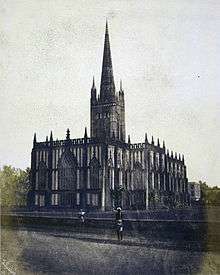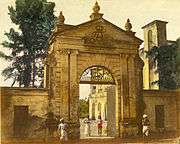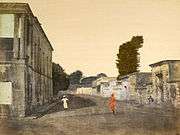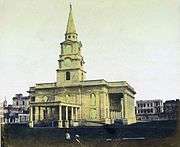Frederick Fiebig
Frederick Fiebig was a photographer, best known for his photographs of India, Sri Lanka, Mauritius, and South Africa taken in the 1850s.[1]

History
There is very little information available about Frederick Fiebig. He was probably of German origin and became a lithographer in Calcutta in the 1840s. He should not be confused with his contemporary and German compatriot, the Letton born post impressionist and expressionist painter Frédéric Fiebig. He was possibly also a piano teacher for a time.[2] With the advent of photography, Fiebig began producing hand-coloured prints of photographs captured using the calotype process. His photographs of Calcutta are some of the earliest views of the city. He later travelled to Madras, Colombo and Kandy in Sri Lanka, Mauritius, and Cape Town in South Africa, meticulously cataloguing the monuments and people around him. The East India Company acquired roughly 500 of his photographs in 1856[1] which are now part of the Oriental and India Office collections at the British Library.[3]
Gallery
 Gateway to the former Danish settlement of Serampore (also called Frederiksnagore by the Danes) on the Hoogly River north of Calcutta, 1851.
Gateway to the former Danish settlement of Serampore (also called Frederiksnagore by the Danes) on the Hoogly River north of Calcutta, 1851. A street in Chandernagore, French India. Hand-coloured salt print, 1851
A street in Chandernagore, French India. Hand-coloured salt print, 1851 English: "Photograph of Black Town in Madras, India, taken in c.1851.".
English: "Photograph of Black Town in Madras, India, taken in c.1851.". "St John's Cathedral, Calcutta," hand-coloured photographic print by Frederick Fiebig, dated 1851.
"St John's Cathedral, Calcutta," hand-coloured photographic print by Frederick Fiebig, dated 1851.
Bibliography
| Wikimedia Commons has media related to Frederick Fiebig. |
- John Hannavy, Encyclopedia of nineteenth-century photography, New York : Routledge, 2008.
References
- Library, British. "Palace of the Nawaub of the Carnatic, Madras". bl.uk/. Retrieved 22 August 2014.
- Library, British. "Fiebig Collection: Views of Calcutta and surrounding districts". bl.uk/. Retrieved 22 August 2014.
- Raman, A (21 March 2011). "Frederick Fiebig and Madras photos". The New Indian Express. Retrieved 24 August 2014.